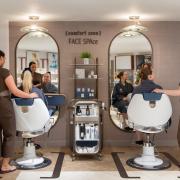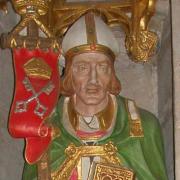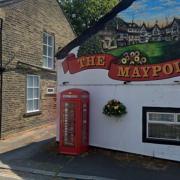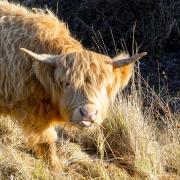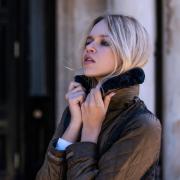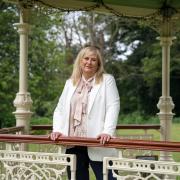Government propaganda posters denounced fashion frivolity during the First World War declaring: ‘To dress extravagantly in war time is worse than bad form, it is unpatriotic.’

In the early weeks of the conflict, many wealthy women responded by cancelling orders for new gowns and shunned the shops, but then something changed. Fashion began to re-establish its influence, with new, more extravagant styles emerging as the conflict wore on.
‘There is very little written about the fashion of the time,’ said York-based fashion historian Lucy Adlington. ‘It’s deemed trivial even though it’s a vital strand of women’s history.

‘We do know, however, that while some women eschewed fashion almost as soon as war broke out, this was also a time that marked a boom in style magazines – the British edition of Vogue, for example, was launched in autumn 1916.’

Lucy, who stages costume-in-context presentations as part of her business History Wardrobe, has done her bit to redress the balance when it comes to the history of women’s fashion by writing her own book, Great War Fashion: Tales from the History Wardrobe (The History Press, £25). She’s also hosting an event at Brodsworth Hall near Doncaster, on August 2nd, showing how the First World War influenced fashion as part of the South Yorkshire country estate’s series of events marking the 100th anniversary of the conflict .
‘The war marked a great change for women,’ she explained. ‘They were allowed out without chaperones, they could drink, they could dance and, if they saw fit, they could wear clothes that were completely impractical.
‘Some women actually went to something of a frivolous extreme, with more lace and bows and fabric, while others took the opportunity to wear clothes with a much looser structure.’
The most controversial style of the war years was the 1915 introduction of very full, wide, calf-length skirts, sometimes called ‘war crinolines’. Not only did they reveal the lower limbs (yes, right up to the boot tops), they also used many yards of fabric at a time when textiles were hard to obtain.
Mid-war styles echoed the romantic lines of the 1830s with high waists and extravagant sleeves, while fabrics were embellished with wool, silk and even spangled embroidery, as well as bobbles, fringing, fur trims and beads.
‘Pockets were introduced for the first time,’ said Lucy. ‘And handbags – especially lovely leather attaché bags – became much more popular.
‘Silk pyjamas for women also made an appearance because they were easy to wear during air-raids – although what protection they might provide from a zeppelin isn’t clear.’
Prominent stores like Harrods, Harvey Nichols and Debenhams did good business during the war, as did couture designers like Lucile Ltd – led by Lady Lucy Duff Gordon, a Titanic survivor who made dresses for royalty and Hollywood stars like Mary Pickford. And ordinary people became their own fashion designers, making their own clothes from scratch or recycling old fabrics.
‘Women became adept at recycling and upcycling clothes,’ said Lucy. ‘They created shorter, A-line dresses out of old silk crinolines and, while the daytime colour palette tended to be limited to brown, black, white and navy, in the evening, soft pastels in even softer fabrics were introduced.’
Some women cut their hair short during the war years because of lice infestation, but others were inspired by the dancer Irene Castle. In their case it was very much a fashion choice, not a necessity.
Lucy didn’t cut her hair for us (that would have been above and beyond the call of duty), but she did agree to model some of the key wartime pieces from her own collection for us in the gloriously atmospheric surroundings of Brodsworth Hall. So, are First World War fashions actually comfortable?
‘Well, the clothes grip a little just under the ribs but, after 1914, styles did become significantly looser,’ said Lucy, as she rustled about the corridors of Brodsworth in a brown silk gown with a stunning, fiery orange petticoat. ‘They’re a lot more comfortable than 1950s’ clothes, which are virtually impossible to walk or breathe in.’
Women were definitely given more room to breathe in the war years, both physically and metaphorically, embracing all manner of new freedoms – freedoms they were not keen to relinquish once peace was declared.
‘Women had tasted freedom and they liked it,’ said Lucy. ‘Wars always bring change and I honestly believe that the Great War marked the dawn of the modern woman’s wardrobe.’
Lucy Adlington’s demonstration of early 20th century style – Great War Fashion – will be held at Brodsworth Hall at 7.30pm on Saturday August 2nd. For further information or to book your ticket, call 01302 722598 or visit english-heritage.org.uk.
Duty calls
Brodsworth Hall has joined forces with eight other prime Yorkshire heritage sites – Beningbrough Hall, Castle Howard, Fairfax House, Kiplin Hall, Lotherton Hall, Newby Hall, Nostell Priory and Sewerby Hall – to stage a series of exhibitions exploring the impact various wars have had on country houses and their surrounding communities.
Running until October, Duty Calls uses photographs, paintings, memorabilia and poignant letters and journals to chronicle how estates have faced the hardships of war across three centuries.
Soldiers, Socks and Scullery Maids is Brodsworth’s exploration of both world wars through vivid audio recordings, letters home from the trenches and examples from the mammoth knitting campaign carried out by the local community.
The South Yorkshire country house is also hosting a series of lively presentations over the weekend of August 2nd-3rd under the banner A Woman’s War, looking at how the First World War affected women; and Soldiers’ Return on September 6th-7th, which will include music and drama reflecting the way Brodsworth welcomed back some, but sadly not all, its fighting men.








